Trace Chemicals Detected in Big Island Well
 Trace levels of organic chemical have been detected in water samples at the Hawai‘i Department of Water Supply Kukuihaele water system on the Big Island, the Hawai‘i Department of Health Clean Water Branch said Tuesday.
Trace levels of organic chemical have been detected in water samples at the Hawai‘i Department of Water Supply Kukuihaele water system on the Big Island, the Hawai‘i Department of Health Clean Water Branch said Tuesday.
During routine sampling of drinking water systems across the state, organic chemicals were identified in water samples collected at the Hawai‘i Island site, as well as in the Haiku Town Water Association, Inc. water system on Maui.
Atrazine was detected in the Kapulena Well of the Kukuihaele water system, which serves approximately 450 residential customers near Waipio Valley.
The Haiku Town Water Association, Inc. water system is a small residential system, which serves approximately 65 persons in Haiku, Maui. Chemicals 1,2-Dibromochloropropane (DBCP) and 1,2,3-Trichloropropane (TCP) were detected in the Haiku Town Association, Inc. HT-1 Well.
“These trace levels of the chemicals do not pose a public health threat, and the waters from these wells are safe to drink,” said Keith Kawaoka, deputy director for environmental health. “The Department of Health will continue to work together with these water systems to ensure tests for these chemicals continue. Such testing is part of scheduled monitoring regularly conducted to ensure that everyone’s water is safe to drink and public health is not compromised.”
Drinking water from these wells remains safe, as the trace levels detected were below the US Environmental Protection Agency (EPA) and State Maximum Contaminant Level (MCLs) for these contaminants, according to a DOH press release.
Atrazine was confirmed in the Kapulena Well at 0.054 ppb, well below the federal and state standard of 3 ppb. Atrazine is an herbicide used on row crops such as sugar cane. Atrazine had been previously reported in the Kukuihaele water system at a level of 0.27 ppb in 2011.
The DBCP level confirmed at the HT-1 Well was 0.02 parts per billion (ppb). This trace level is one‑tenth of the EPA MCL of 0.200 ppb. The state of Hawai‘i has a more stringent MCL of 0.04 ppb, and the concentration found was also lower than the state’s more stringent level.
EPA defines the MCL as the highest level of a contaminant that is allowed in drinking water. The standards are set to avoid human health risks based on a lifetime of consuming water containing that level of contaminant. DBCP was a soil fumigant and nematicide that was used during pineapple cultivation.
1,2,3-Trichloropropane (TCP) was confirmed at 0.11 ppb, which is below the state MCL of 0.6 ppb. There is no federal standard for TCP. The presence of DBCP and TCP in the sample is attributed to the former cultivation of pineapple on the site itself, the release said.
The use of the soil fumigants containing these contaminants ended in the mid-1980s, suggesting that the detected levels are not expected to increase in the future.
Water from these water systems is tested as mandated by federal and state drinking water regulations. To date, these water systems continue to be in full compliance with all federal and state standards for drinking water, the release said.












